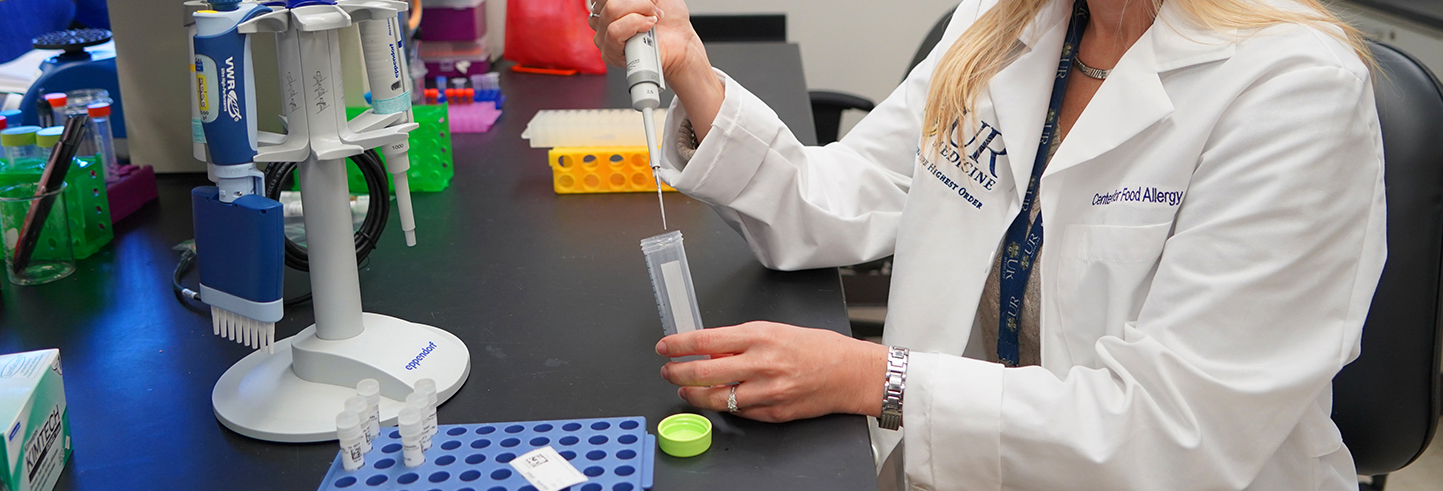Järvinen-Seppo Lab
Overview
Food allergies impact 6-8% of children in the U.S. Among them, peanut allergy is the most common cause of fatal and near-fatal food allergic reactions and is rarely outgrown. Its prevalence has steadily increased in children to over 1% during the past couple of decades. There is a more modest increase in other food allergies, including cow's milk, egg, wheat, tree nut, fish and shellfish allergy. The exact mechanisms contributing to the increase in food allergies are unknown. However, the infant microbiome and perinatal environmental factors, including farming vs. urban life-style, infant and maternal diet, immune status and breastfeeding may play a critical role.
Dysbiosis has been shown to precede the development of atopic dermatitis and food allergy, which typically initiate the “atopic march”, i.e. the progression to allergic rhinitis and asthma later in life. The infant gut microbiome is initially dominated by Bifidobacteria, especially in breastfed infants, due to human milk oligosaccharides that do not serve as fuel for the host but for the microbiome. By two years of age, the gut microbiome starts to resemble adult-like microbiome. This time frame coincides with is a rapid development of the immune system and presents a critical window of opportunity for prevention of allergic diseases.

Kirsi M. Jarvinen-Seppo, M.D., Ph.D.
Principal Investigator
Current Research Focus
The current focus of the Järvinen-Seppo Laboratory is to characterize the differences in the systemic and mucosal immune function and the microbiome in infants born in farming and urban lifestyle environments, as well as to explore the components present in human milk that may modify the infant's developing immune system and oral tolerance to foods. Utilizing samples from infant cohorts, tissue culture models and state-of-the-art immunologic assays and microbiome analyses, our translational research program aims at better understanding of the mechanisms of allergic sensitization and designing novel strategies for the primary and secondary prevention of atopic diseases in childhood.
Main Methods Used in Our Laboratory
- Tissue culture based methods (Epithelial and immune cell culture, reporter cell lines, enteroids and co-culture assays)
- Immunologic assays (ELISA, Luminex, Western Blot)
- Flow cytometry, CyTEK, Immunofluorescence microscopy
- Expression analysis (RT-qPCR, transcriptomic profiling)
- Microbiome analysis (16S and shotgun metagenomic sequencing)
- Metabolite assessment
Why It's Important
This work aims at designing better strategies for the primary and secondary prevention of allergies in childhood.
Recent Publications
- Approach to the spectrum of infant non-IgE-mediated food allergy manifestations and physiologic infant behaviors.; Current problems in pediatric and adolescent health care. 2025 Apr 07.
- Updates to the role of diet in atopic dermatitis.; Journal of the American Academy of Dermatology. 2025 Mar 29.
- Effect of Feeding Human Milk on Development of the Infant Immune System and Allergic Outcomes-An Area of Research Challenge and Need.; Breastfeeding medicine : the official journal of the Academy of Breastfeeding Medicine. 2025 Feb 05.
- A Phenotypically Distinct Human Th2 Cell Subpopulation Is Associated With Development of Allergic Disorders in Infancy.; Allergy. 2025 Feb 03.
Lab Members
Kirsi M. Järvinen-Seppo, M.D., Ph.D.
Principal Investigator
Profile: Kirsi M. Järvinen-Seppo, M.D., Ph.D.
Kirsi_Järvinen-Seppo@urmc.rochester.edu
Antti E. Seppo, Ph.D.
Research Associate Professor
Profile: Antti E. Seppo, Ph.D.
Antti_Seppo@URMC.Rochester.edu
Other Lab Members include:
Postdoctoral Fellows, Ph.D. Students, Lab Technicians, Ph.D. Students, Undergrads, and Human Subjects Research Coordinators.
Affiliations
News & Events
- Apr. 19, 2023 - Nothing to Sneeze at: Study Seeks to Understand Allergic Resistance of Old Order Mennonites.
- November 10, 2021 - Immunity from both prior infection and vaccination produces antibody response in breast milk.
- April 8, 2021 - The New York Times - "Vaccinated Mothers Are Trying to Give Babies Antibodies Via Breast Milk"
- February 10, 2021 - URMC research sheds light on breastfeeding while COVID-positive. Joint Research Project Update.
- June 8, 2020 - Joint Research Project will examine whether mothers can transmit COVID-19 through breast milk, and whether the breast milk itself has immunological properties against the disease.


